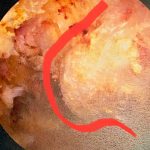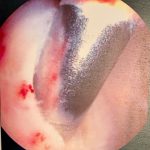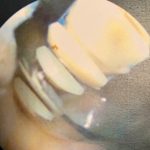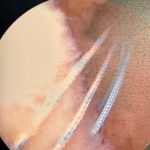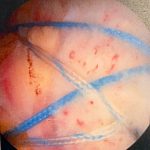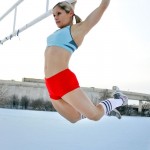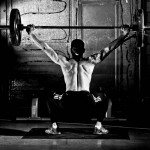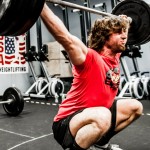Brian Schiff’s Blog
Injury Prevention, Sports Rehab & Performance Training Expert
For those following along with my post-op journey, this marks days 15 – 21. I saw the MD for my first post-op follow-up on Friday June 4 (day 15 post-op). He told me I could get rid of the pillow that came with my sling. I was thrilled as it is summertime and that thing was bulky and hot.
Surgical pictures
- Large bone spur
- 1 cm tear in supraspinatus
- Anchor
- Sutures
- Finished repair
You can see from the bone spur outlined in red above that my tear was an caused by repetitive micro trauma over time. Eventually, the tendon became tattered and torn. All the years of weight training probably contributed to some of this, as well as my type 2 acromion. I ended up with three total anchors and a suture bridge repair.
Rehab
I wish I could say all my years stretching patients made rehab easy for me, but that is not the case. Stiffness, weakness, soreness and atrophy were now a reality for me. My external rotation motion was beginning to improve, however, overhead flexion continued to be painful and stiff. My PT could get me to about 90 degrees of flexion while laying on my back, but with a significant amount of discomfort. It was more comfortable in the scapular plane.
The visits consisted of:
- Heat x 10 minutes
- Pendulums
- PROM by the PT for about 30 minutes – external rotation (ER) and scaption
- Passive cane ER in scapular plane and seated
- Table slides and seated forward bow (more in scapular plane)
- Active side-lying scapular movement – elevation, depression, protraction/retraction
- Scapular retractions (shoulder blade squeezes)
- Game Ready
The Backstory
It all began with a burning sensation in my left shoulder in November 2020 with a simple gesture. I did not give it a second thought, as it subsided in a few minutes. However, I soon began to notice more regular pain with certain movements and difficulty sleeping at night. Honestly. I thought it would subside and chalked it up to some mild rotator cuff inflammation. For years, I had avoided overhead lifts and heavy bench press, while restricting range of motion to reduce stress on my shoulders. With that said, this pain led to me further modifying my workouts.
A few weeks later, the nocturnal pain became more intense and prevalent. I knew it was time to formally rehab my shoulder. So, I did what I would advise my patients to do. I embarked on 6 weeks of rotator cuff and scapular strengthening 3x/week, while using laser, ice, and non-steroidal anti-inflammatory meds to resolve the pain. I stuck religiously to this plan from mid December to the end of February. Unfortunately, nothing helped. Sleeping was interrupted consistently, and my function was limited.
As such, I sought the counsel of a trusted surgeon I work closely with. He ordered an MRI, which revealed a 1 cm near full-thickness tear in the supraspinatus tendon, a type II acromion and a big anterolateral bone spur. As you can see from the list below, I have a borderline medium-size tear.
Rotator Cuff Tear Classification:
Small < 1 cm
Medium 1-3 cm
Large 3-5 cm
Massive > 5 cm
Shoulder pain is one of the most common issues I treat in my clinic week to week, There are many causes of pain, but the most common cause of shoulder pain in active individuals typically involves the rotate cuff. These relatively small muscles are called upon to manage high and repetitive loads during sports, work and daily activity.
In some cases, there is just mild inflammation that does not limit function. In there cases, there is more acute pain that makes it hard to even raise the arm or use it for the most basic things. It can be difficult to really discern if there is significant injury as even acute tendinitis can be debilitating.
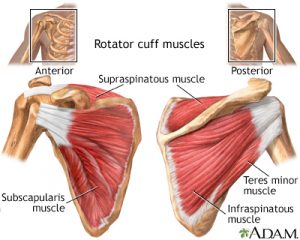
Image courtesy of Medline Plus
In a blog post I wrote for my work site, I discuss the differences between tendinitis, tendinosis and tears of the rotator cuff. Click here to read more.
If you have rotator cuff pain and are looking for a simple at-home rehab plan or injury prevention program, check out my training guide at www.rotatorcufftraining.com.
There are several things that contribute to shoulder impingement and rotator cuff pain. Perhaps one of the biggest issues that impacts overhead athletes, Crossfit enthusiasts and the avid weight lifter is limited shoulder mobility. Poor flexibility in the pecs, lats, posterior shoulder as well as limited thoracic spine extension and rotation all contribute to suboptimal movement.
Poor mobility can place the scapula in biomechanically flawed positions, increase glenohumeral internal rotation and restrict shoulder movement at end range creating compensatory movement and pain. The video below is a snippet from my upcoming webinar on rotator cuff dysfunction and nonoperative treatment.
This webinar will be great for strength coaches, exercise enthusiasts, Crossfit athletes/coaches, athletic trainers and physical therapists. If you want to attend the webinar or catch the on-demand version, simply visit www.alliedhealthed.com. In addition, you may find my DVD on rotator cuff training very helpful in overcoming shoulder pain and staying pain free in the gym.
Click here to see a brief video overview of the DVD or visit my site at www.BrianSchiff.com for more info. Use the code Holiday15 at checkout from today until December 25 to save $10 off the retail price.
Have a great Thanksgiving and enjoy your time with family and friends!
So, I treat a number of fitness enthusiasts in the clinic and many include Crossfit clients. Recently, I evaluated a 38 y/o male on 2/16/12 with a 3 month history of right shoulder pain. He performs Crossfit workouts 6 days per week. His initial intake revealed:
- Constant shoulder pain that worsens with overhead movements
- Pain with bar hangs, overhead squats and wide grip snatches
- Unable to do kipping (only doing strict form pull-ups)
- Pain if laying on his right side at night
- No c/o neck pain, referred pain or numbness/tingling
Notice the shoulder position during the kipping pull-up and overhead squat below. This is a position of heightened risk for the shoulder.
His exam revealed the following:
- Normal range of motion
- Strength within normal limits except for supraspinatus and external rotation graded 3+/5 with pain
- Positive impingement signs
- Negative shrug sign
- Negative Speed’s and O’Brien’s test
- Tender along distal supraspinatus tendon
Based on the clinical exam, it was apparent he had rotator cuff inflammation and perhaps even a tear. Keep in mind he had not seen a physician yet. I began treatment focused on scapular stabilization and rotator cuff strengthening as well as pec and posterior capsule stretching to address the impingement. Ultrasound and cryotherapy were used initially to reduce pain and inflammation.
One month following the eval
By 3/14/12, his pain was resolved with daily activity and he had returned to snatches and push-press exercises without pain. He still could not do overhead squats with the Olympic bar pain free, but he could with a pvc pipe. Strength was now 4/5 for supraspinatus and 4+/5 for external rotation. All impingement tests were now negative as were Speed’s and O’Brien’s testing.

